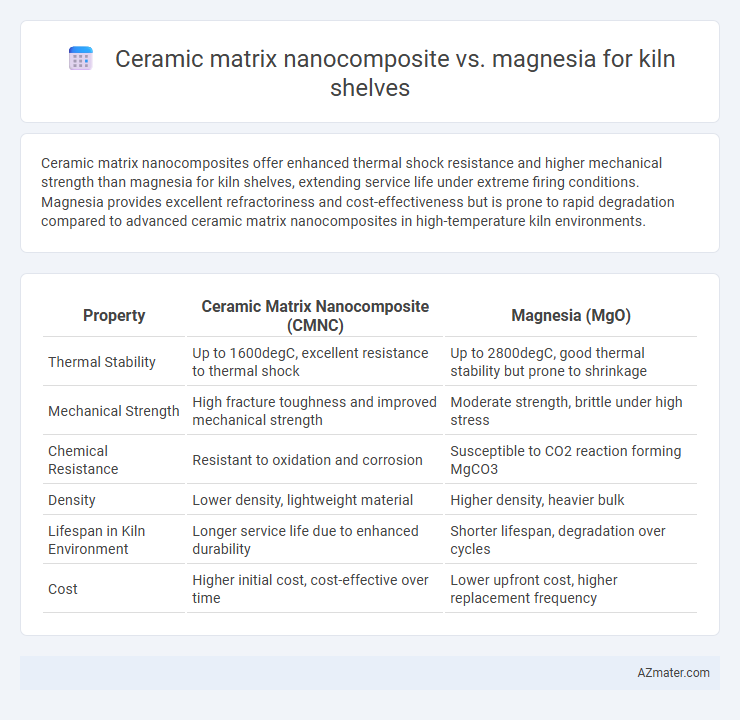Ceramic matrix nanocomposites offer enhanced thermal shock resistance and higher mechanical strength than magnesia for kiln shelves, extending service life under extreme firing conditions. Magnesia provides excellent refractoriness and cost-effectiveness but is prone to rapid degradation compared to advanced ceramic matrix nanocomposites in high-temperature kiln environments.
Table of Comparison
| Property | Ceramic Matrix Nanocomposite (CMNC) | Magnesia (MgO) |
|---|---|---|
| Thermal Stability | Up to 1600degC, excellent resistance to thermal shock | Up to 2800degC, good thermal stability but prone to shrinkage |
| Mechanical Strength | High fracture toughness and improved mechanical strength | Moderate strength, brittle under high stress |
| Chemical Resistance | Resistant to oxidation and corrosion | Susceptible to CO2 reaction forming MgCO3 |
| Density | Lower density, lightweight material | Higher density, heavier bulk |
| Lifespan in Kiln Environment | Longer service life due to enhanced durability | Shorter lifespan, degradation over cycles |
| Cost | Higher initial cost, cost-effective over time | Lower upfront cost, higher replacement frequency |
Overview of Ceramic Matrix Nanocomposites and Magnesia
Ceramic matrix nanocomposites (CMNCs) consist of ceramic matrices reinforced with nanoscale particles, enhancing mechanical strength, thermal stability, and resistance to thermal shock compared to conventional ceramics. Magnesia (MgO), widely used for kiln shelves, offers excellent refractory properties including high melting point, chemical inertness, and thermal conductivity but may suffer from grain growth and structural degradation at elevated temperatures. CMNCs provide improved toughness and durability over magnesia shelves, leading to longer service life and better performance in high-temperature kiln environments.
Material Composition and Structure
Ceramic matrix nanocomposites for kiln shelves typically consist of a ceramic base material reinforced with nanoscale particles such as carbon nanotubes or silica nanoparticles, enhancing thermal shock resistance and mechanical strength. Magnesia kiln shelves are primarily composed of magnesium oxide crystals, offering high refractoriness and excellent resistance to chemical attack but lower toughness compared to nanocomposites. The nanocomposite's integrated nanoscale reinforcements create a more refined microstructure, improving fracture toughness and thermal stability beyond the coarse-grained, crystalline structure of magnesia.
Thermal Stability and Heat Resistance
Ceramic matrix nanocomposites exhibit superior thermal stability and heat resistance compared to magnesia, maintaining structural integrity at temperatures exceeding 1600degC due to enhanced grain boundary strength and reduced thermal conductivity. Magnesia kiln shelves typically withstand temperatures up to 1500degC but are prone to deformation and grain growth under prolonged thermal exposure, limiting their lifespan in high-temperature applications. The nanoscale reinforcement in ceramic matrix composites significantly improves resistance to thermal shock and oxidation, making them ideal for advanced kiln shelf performance in extreme heat environments.
Mechanical Strength and Durability
Ceramic matrix nanocomposites exhibit superior mechanical strength and enhanced fracture toughness compared to magnesia, making them more suitable for high-stress kiln shelf applications. Their nanoscale reinforcement significantly improves crack resistance and thermal shock durability, extending shelf lifespan under extreme temperature fluctuations. Magnesia, while offering good high-temperature stability, generally falls short in mechanical resilience and wear resistance when compared to advanced ceramic matrix nanocomposites.
Weight and Handling Efficiency
Ceramic matrix nanocomposites offer significantly reduced weight compared to traditional magnesia kiln shelves, enhancing handling efficiency during installation and maintenance. The lower density of ceramic matrix nanocomposites decreases physical strain, facilitating quicker repositioning and reducing labor costs. These materials also exhibit superior thermal stability and mechanical strength, ensuring durability while maintaining lightweight benefits.
Chemical Corrosion Resistance
Ceramic matrix nanocomposites exhibit superior chemical corrosion resistance compared to magnesia for kiln shelves, due to their enhanced structural stability and reduced porosity, which minimizes reactive element penetration. Magnesia shelves, while resistant to basic slags, suffer degradation in the presence of acidic slags and volatile compounds, leading to accelerated corrosion and reduced lifespan. Advanced ceramic nanocomposites maintain integrity under aggressive kiln atmospheres, making them a more durable choice for chemical corrosion-intensive environments.
Performance in Repeated Firing Cycles
Ceramic matrix nanocomposites exhibit superior thermal shock resistance and mechanical strength compared to magnesia, maintaining structural integrity over extended repeated firing cycles in kiln shelf applications. Their enhanced fracture toughness reduces crack propagation and wear, leading to longer service life under fluctuating high temperatures. Magnesia, while cost-effective and thermally stable, tends to degrade and spall more quickly under cyclical thermal stresses, limiting its durability in intensive kiln environments.
Cost Implications and Economic Viability
Ceramic matrix nanocomposites offer enhanced thermal stability and wear resistance compared to magnesia kiln shelves, potentially reducing replacement frequency and maintenance costs. However, the initial investment for ceramic matrix nanocomposites is significantly higher due to advanced materials and fabrication processes, impacting upfront capital expenses. Magnesia shelves remain economically viable for standard applications due to lower material costs, but may incur higher long-term costs from shorter lifespan and susceptibility to thermal shock.
Environmental Impact and Sustainability
Ceramic matrix nanocomposites (CMNs) offer enhanced durability and thermal stability compared to traditional magnesia kiln shelves, reducing the need for frequent replacements and minimizing material waste. CMNs often incorporate eco-friendly raw materials and enable lower energy consumption during production due to improved thermal efficiency, contributing to a reduced carbon footprint. In contrast, magnesia kiln shelves, while widely used, involve high-energy processing and generate more industrial waste, posing greater challenges for sustainability and environmental impact management.
Recommendations for Kiln Shelf Applications
Ceramic matrix nanocomposites offer superior thermal shock resistance and mechanical strength compared to magnesia, making them ideal for high-temperature kiln shelf applications requiring durability and extended lifespan. Magnesia shelves provide excellent corrosion resistance and cost-effectiveness for moderate-temperature and less demanding environments, but their susceptibility to cracking under rapid thermal cycling limits their use in advanced firing processes. For kiln shelves exposed to frequent thermal cycling and high-stress conditions, ceramic matrix nanocomposites are recommended for enhanced performance and reduced maintenance costs.

Infographic: Ceramic matrix nanocomposite vs Magnesia for Kiln shelf
 azmater.com
azmater.com